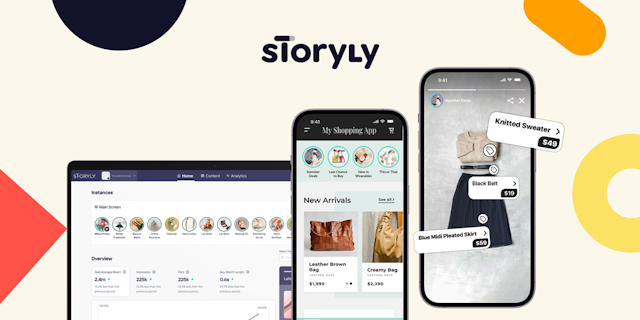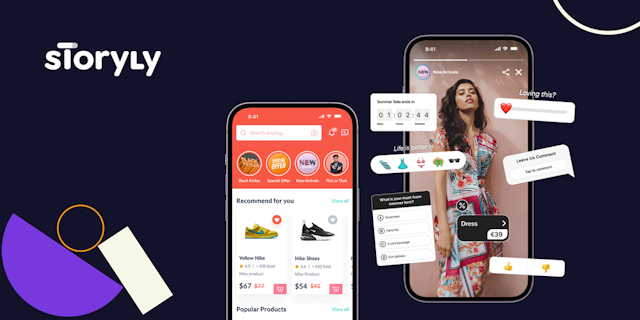Audiences are increasingly looking for full-screen, personalized, interactive experiences on mobile. So how can brands amplify engagement through a new kind of mobile marketing channel, Stories?
The way we consume technology is changing rapidly, and marketers are struggling to keep up. Mobile phones are now one of the most popular ways to shop online, with 43% of generation Z and 48% of millennials shopping online at least once a week on their mobile phone. Insider Intelligence predicts that mobile commerce (m-commerce) volume will reach $620.97bn, and account for 42.9% of all e-commerce in 2024. Despite this, mobile marketers are still focusing on the same conventional channels they have been using for years such as SMS, email, pop-up, push notifications, banners, and carousels.
It is becoming clear that these conventional channels are no longer enough to keep users interested and engaged. They all have different challenges. They take up only a small part of the screen, they have few interactive elements. They lack the flexibility that brands need to reflect their creativity today and eventually diminish the impact of the message they are trying to deliver in such a limited screen size. They cannot compete with full-screen, distraction-free environments that inspire deeper engagement with audiences.
Stories are rapidly becoming the leading mobile format
According to an Instagram Trends research study commissioned by Facebook, 91% of 4,500 active Instagram users say they watch videos on Instagram weekly. Furthermore, 50% of Instagrammers have visited a website to buy a product/service as a result of seeing it in Stories. Likewise, according to Forrester Consulting, 64% of users preferred content delivered in a tappable Story format over the scrolling article equivalent. The authenticity, interactivity, and snackability of Stories make them indispensable.
Stories have the potential for more interactivity than any other channel, and this potential spans far beyond the circles at the top of the Instagram app. They can be integrated into any mobile app and website today, and allow brands to show videos and pictures, add product tags, and create quizzes or question stickers to gather data from their target audience to retarget them in the future.
Stories were first released by Snapchat in 2013, meaning they have now been in use for almost a decade. Users are very familiar with them and can navigate them well. Unlike other user interface elements designed for desktop and later adapted to mobile, Stories are the first content format designed solely for mobile creation and consumption.
One of the most notable features of Stories is that they contrast with the traditional highly-curated corporate social media feeds. They essentially offer audiences a “backstage peek” into the brands they love. This creates a more informal, off-the-cuff experience that millennials and gen Z crave.

A new kind of engagement channel
Storyly is a mobile user engagement platform that is transforming the immersive, full-screen experience of Stories into a new kind of channel that allows brands to embed Stories into any mobile app or website.
Brands can create App Stories, Web Stories, or interactive Shoppable Videos to engage their audiences. More recently, Storyly has created another product that complements it, ‘Moments by Storyly’, a community engagement solution for mobile apps that lets users instantly create and share full-screen Stories. The lightweight software development kit (SDK) of Storyly can be integrated easily, enabling the creation of engaging experiences without any development efforts after integration.
“Visit Footasylum’s website or mobile app, for instance – you will see Stories in the shape of rectangles,” says Emre Fadillioglu, chief executive officer and co-founder of Storyly. “And when you click on them, they just pop up as full-screen Stories like those that you see on other social media platforms, offering richer content than any other engagement tool. And there’s premium nutrition and wellness product OLLY – which has combined product discovery and interactivity with Storyly Stories on their website. Both are also great examples of how Stories can take any shape to fit the style of the app or website.”
This will give brands the opportunity to engage new users by leveraging full-screen, uninterrupted experiences that utilize swipe-ups, shareable promo codes, call-to-action buttons, interactive stickers, and product tags that gamify the shopping experience and lead visitors directly to checkout. Brands can also target repeat customers with personalized stories tailored to customers’ interests and preferences.
Storyly is already trusted by over 300 brands in more than 40 countries. It recently helped Domino’s Pizza, the multinational pizza restaurant chain, to increase its campaign conversions through Stories. Domino’s observed a 64% higher conversion rate by communicating campaigns through in-app Stories powered by Storyly compared to banners, and 37% of users clicked through to the campaign detail page after viewing the brand’s Stories. The use of the Domino’s wallet feature also increased by 20% after the feature was amplified by in-app Stories.
“The real challenge for brands starts after the user acquisition. Growth is also about user retention and that means effective engagement efforts,” says Fadillioglu. “But in this noisy world where users’ consideration span is shrinking, it is easier said than done. 25% of every new app downloaded is abandoned after only one use and 97% of users are gone forever in 30 days’ time.”
He continues: “This is where Storyly Stories’ magic shines through. Using them, marketers are empowered with a content layer that allows for direct communication and engagement opportunities from onboarding to retention, conversion to advocacy. More than 64,000 Storyly Stories were published in 2022 and so far, with over 200 million monthly active users, they have been watched 500 million times in 169 countries.”

Leveraging zero-party data to target users
With the upcoming demise of third-party cookies, marketers are scrambling for new ways to collect data to find out what their audiences are interested in. McKinsey’s Next in Personalization 2021 report suggests that 71% of consumers expect personalized interactions with brands and, predictably, get frustrated when they don’t.
Many businesses are looking for new ways to collect zero-party data – data that customers proactively share with brands – from their audiences. One of Storyly’s newest features, ‘audience builder’, is designed to encourage zero-party data collection. It allows brands to ask their audience a question, and then use the answers to create and target multiple audiences based on the answers they provide.
“So in the app, you publish a story, and you ask me the question: ‘what’s your favorite color?’ I answer ‘blue,’ and then you collect all the people that like blue and then you start to target them with relevant content,” explains Fadillioglu.
Over the next few years, the internet is set to become even more privacy-centric. As brands rely more heavily on zero-party data, interactive Stories will become a key way for marketers to understand and engage with their audience.
“It is a constant challenge for digital marketers to maintain a balance between providing personalized experiences for their users and respecting their privacy,” says Fadillioglu. “Despite the abundance of information on user behavior on the internet, not all data is valuable, reliable, or usable, and high-quality user data is essential for brands to inform their product and content strategies.
“Zero-party data is a golden opportunity and the new ‘must-have’ for marketers in the cookieless world. And full-screen interactive elements such as polls, quizzes, and question stickers make it possible to do it all in a non-intrusive and truly fun and engaging way. In 2022, our customers got to ask 20,000 questions to their users with these interactive stickers, which would take thousands of survey forms otherwise.”
Stories have quickly become one of the most accurate and trustworthy ways to find out what users want, while also increasing engagement and facilitating brand loyalty. As m-commerce continues to grow, the most successful brands will be the ones that learn how to make data collection a fun and immersive part of the user experience.
To learn more about what Storyly has to offer, click here.
.